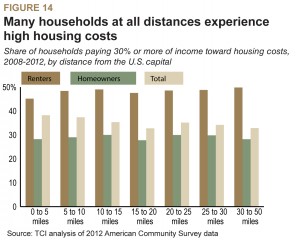From the outside, the Washington area economy appears to be doing very well. Unemployment is lower here than in the rest of the US and incomes are comfortable for many. But a closer look reveals that, in fact, most of the region’s residents are struggling. Wages are down and jobs are scarcer for those without a college degree. Income inequality is growing and poverty is up. And rising housing costs force residents to move farther out to find cheaper housing, saddling many of us with long and expensive commutes.
These are some of findings in a new report, Bursting the Bubble: The Challenges of Working and Living on the National Capital Region, by DCFPI, the Commonwealth Institute (located in Virginia) and the Maryland Center on Economic Policy. Here are five charts that demonstrate how tough it is for most workers in the region:
Wages are falling for most workers. Wages fell from 2007 to 2012, after adjusting for inflation for all workers other than those with a college degree. (See Figure 1.) The result is a growing wage gap.
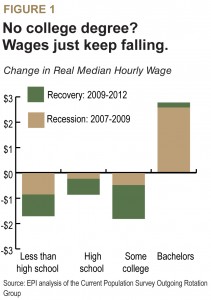
Income inequality is rising. For every dollar a high-wage worker makes in the region, a low-wage worker earns just 16 cents. (See Figure 2.) Not only has this trend worsened since the recession, the earnings disparity is more extreme here than in the nation as a whole.
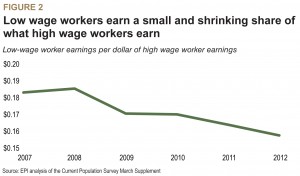
Jobs are scarce for all workers except those with advanced education. The Washington region has lost 110,000 jobs for workers without a college degree since the recession, with the biggest drops in the transportation, utility, and construction and trade industries. (See Figure 4.)
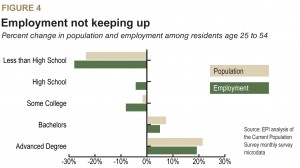
Poverty is increasing. With wages and employment falling for so many workers, poverty rates are on the rise in the region. (See Figure 10.)
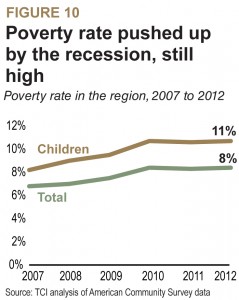
High housing costs take a big bite out of workers’ paychecks everywhere. Half of all rental households and one third of homeowners in the region spend more than 30 percent of their income on housing, or what the US Department of Housing and Community Development considers affordable. Even moving farther from the core of the region in search of cheaper housing doesn’t seem to help; the share of residents who are cost-burdened is fairly constant no matter your distance from the Capitol. (See Figure 14.)
With so many residents in the region struggling to hold on, leaders should come together for regional solutions. The recent collaboration between DC, Montgomery County, and Prince George’s County to raise the minimum wage is a good example of leaders working together to help make work pay. More regional collaboration on job and skills training, access to post-secondary education, and the creation and preservation of affordable housing could help ensure workers of all income levels can benefit from the region’s prosperity.
To read the complete report, click here.
To print a copy of today’s blog, click here.

